Written by Joshua Fleming and Marissa Gallardo :February 25, 2015
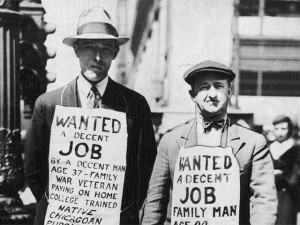
Men from the Great Depression looking for jobs
During the 1930s, The Great Depression and also the Dust Bowl hit the American business man and farmers very hard which created a lot of unemployed workers in search of new jobs. While this was happening, there was a major migration movement to California to fight for the limited and low wage jobs. The migration of a wide, diversified groups of people brought along their cultures, possessions, and music including Rock ‘n’ Roll, Western Swing, Honky Tonk, and Rockabilly.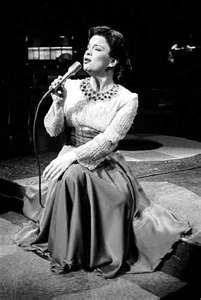 Eventually the intermixing of everyone’s music allowed for the development of Bakersfield Sound which is defined by the influences of the rock ‘n’ roll electric guitar and drums and the upbeat, dance tempo of Western Swing on Honky-Tonk, barroom music. The instrumentation throughout Bakersfield Sound is what set it apart from Nashville Sound, a sub-genre of country music that had a smooth, elegant sound that dominated this era. The “rougher” sound of Bakersfield was also in reaction to Nashville Sound; as they were attempting to get back to the true sound of country music. In the 1950s, Bakersfield Sound started to become more popular later becoming a major success in the 60s.
Eventually the intermixing of everyone’s music allowed for the development of Bakersfield Sound which is defined by the influences of the rock ‘n’ roll electric guitar and drums and the upbeat, dance tempo of Western Swing on Honky-Tonk, barroom music. The instrumentation throughout Bakersfield Sound is what set it apart from Nashville Sound, a sub-genre of country music that had a smooth, elegant sound that dominated this era. The “rougher” sound of Bakersfield was also in reaction to Nashville Sound; as they were attempting to get back to the true sound of country music. In the 1950s, Bakersfield Sound started to become more popular later becoming a major success in the 60s.
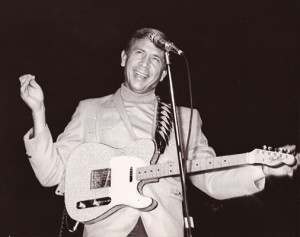
Buck Owens Performing
The leaders of the subgenre include Buck Owens and Merle Haggard. Both artists were considered “too country” for Nashville but were great representatives of what “real country” sounded like for those who were opposed to the pop influences on Nashville Sound. Buck Owens, by far, has had the most influential impact on Bakersfield Sound primarily by implementing the electric guitar, drums, and an upbeat 2/4 tempo into his music to create his “Freight Train” sound that was identifiable in many of Buck’s albums and hit songs. As the artists of Bakersfield sound dealt with the hardships of the aftermath of the Depression and the Dust Bowl, they also sang about it; a big motif and topic of interest at the time was the influence of the Depression and migration on daily lives. Many “okies”, people who migrated from Oklahoma (which was a large portion of the migrators), felt isolated and sometimes humiliated in their new homes. The struggle of their lives shown through in much of the music of the time, including in Merle Haggard’s music; his song topics usually described hardships and heartache. 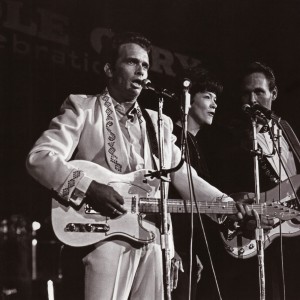 Buck Owens, on the other hand, went completely in the opposite direction withupbeat, dance songs or ballads that talked about heartache and vulnerability at the hands of a woman, which was a relatively new topic in country music seeing as though songs of heartache were centered on the wrong doings of a man.
Buck Owens, on the other hand, went completely in the opposite direction withupbeat, dance songs or ballads that talked about heartache and vulnerability at the hands of a woman, which was a relatively new topic in country music seeing as though songs of heartache were centered on the wrong doings of a man.
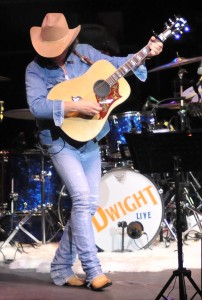
Dwight Yoakam performing
As the subgenre progressed from a blending of culturally influenced sounds to an entertainment based performance, Buck Owens and Dwight Yoakam enhanced their appearance and image in the entertainment industry. Buck Owens usually performed in Nudie Suits and also continued his career on the television show Hee Haw; whereas, Dwight Yoakam was known for a certain sex appeal in country music. Yoakam also became an actor and film director along with his career in music. The expansion of country music’s presence on a larger scale influenced the success of the artists as well as the accessibility of the country music genre as a whole.
Key Figures
Buck Owens 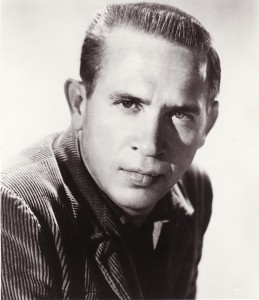 (1929-2006) was extremely influential to the development and the rise of Bakersfield sound. His hillbilly-barroom country was defined by his use of electric guitars, drums and his iconic Freight Train Sound, loud music with an upbeat 2/4 tempo that was clearly identifiable in many of his songs. Buck was “too country” for the Nashville Sound and took his talents to California to eventually create hillbilly rock ‘n’ roll, hip, upbeat country music. His influence spanned many genres as he dabbled in covers of songs such as “Memphis” and “Johnny B. Goode” and was huge fans of The Beatles, as were they of him. Buck Owens experimentally eclectic sound has defined Bakersfield Sound and the path of country music to come.
(1929-2006) was extremely influential to the development and the rise of Bakersfield sound. His hillbilly-barroom country was defined by his use of electric guitars, drums and his iconic Freight Train Sound, loud music with an upbeat 2/4 tempo that was clearly identifiable in many of his songs. Buck was “too country” for the Nashville Sound and took his talents to California to eventually create hillbilly rock ‘n’ roll, hip, upbeat country music. His influence spanned many genres as he dabbled in covers of songs such as “Memphis” and “Johnny B. Goode” and was huge fans of The Beatles, as were they of him. Buck Owens experimentally eclectic sound has defined Bakersfield Sound and the path of country music to come.
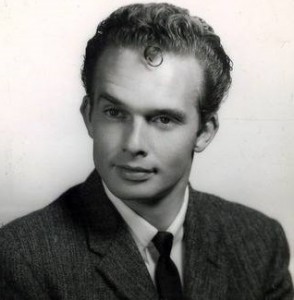 Merle Haggard (b. 1937), a good ol’ “Okie”, traveled to California because of the Depression and its devastating toll it took on his family. Although Merle had a rocky start in his music career, his wife Bonnie Owens helped to propel his career in country music to stardom. Merle was representative of the working man that has struggled through hard times including the Depression, prison and years of heartache and yet still “doesn’t give a damn”; his sound and lyrical topics set him apart from the more upbeat sounds of Buck Owens.
Merle Haggard (b. 1937), a good ol’ “Okie”, traveled to California because of the Depression and its devastating toll it took on his family. Although Merle had a rocky start in his music career, his wife Bonnie Owens helped to propel his career in country music to stardom. Merle was representative of the working man that has struggled through hard times including the Depression, prison and years of heartache and yet still “doesn’t give a damn”; his sound and lyrical topics set him apart from the more upbeat sounds of Buck Owens.
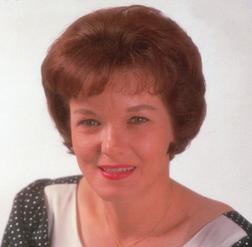 Bonnie Owens (1929-2006) was extremely important to the development of Bakersfield sound, although her own musical career was overshadowed by the careers of her leading men and late husbands, Buck Owens and Merle Haggard. After being the “singing waitress”, Bonnie was able to expand her career and eventually attain a recording deal with Capitol Records. Bonnie never was able to reach the fame and popularity that the men of Bakersfield Sound had but was making enough money from her records to continue recording many albums for many years. Bonnie put her life and career on hold to support the sky-rocketing career of her husband, Merle Haggard, but after a divorce and some reconsideration, she once again returned to her music career as a recording artist and performer.
Bonnie Owens (1929-2006) was extremely important to the development of Bakersfield sound, although her own musical career was overshadowed by the careers of her leading men and late husbands, Buck Owens and Merle Haggard. After being the “singing waitress”, Bonnie was able to expand her career and eventually attain a recording deal with Capitol Records. Bonnie never was able to reach the fame and popularity that the men of Bakersfield Sound had but was making enough money from her records to continue recording many albums for many years. Bonnie put her life and career on hold to support the sky-rocketing career of her husband, Merle Haggard, but after a divorce and some reconsideration, she once again returned to her music career as a recording artist and performer.
Dwight Yoakam (1956) is a representative of the continuation of Bakersfield Sound. Yoakam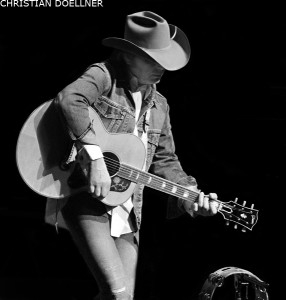 was influenced by Buck Owens and his hip country sound and further shook up the sub-genre with covers of songs spanning many genres and his country star, sex symbol status. Although Yoakam is known for his role in country music, he is also an actor and film director. His versatility in the entertainment world from his music to his acting has allowed him to be immensely popular.
was influenced by Buck Owens and his hip country sound and further shook up the sub-genre with covers of songs spanning many genres and his country star, sex symbol status. Although Yoakam is known for his role in country music, he is also an actor and film director. His versatility in the entertainment world from his music to his acting has allowed him to be immensely popular.
Recommended Listening
Dwight Yoakam—
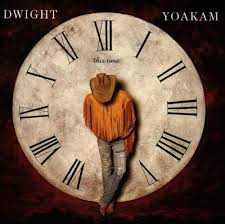 This Time (1993) is an album by Dwight Yoakam, one that he can be very proud of because This Time went triple platinum. Dwight has had much success but no bigger than this album.
This Time (1993) is an album by Dwight Yoakam, one that he can be very proud of because This Time went triple platinum. Dwight has had much success but no bigger than this album.
Guitars, Cadillacs (1986) was a major hit in Dwight Yoakam debut recording album Guitars, Cadillacs, etc., etc. (1986) As the second single from the album, it peaked at No. 4 in the United States and No. 2 in Canada.
Buck Owens—
The Buck Owens Collection 1959-1990 (1992) is a collection of Buck Owens’ music career history. The 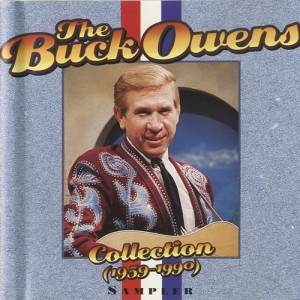 collection depicts all of the traditional sounds of Buck Owens. For those listening for the first time, it will make you a new fan; for those already familiar with Buck, it is a great nostalgic refresher of the talents of the king of “Buckersfield”.
collection depicts all of the traditional sounds of Buck Owens. For those listening for the first time, it will make you a new fan; for those already familiar with Buck, it is a great nostalgic refresher of the talents of the king of “Buckersfield”.
Second Fiddle (1959) was Buck Owens’ first chart entry, although it was never a huge hit. The song is representative of the sounds of his early hits and the heartache at the hands of a woman, which is a topic that was unusual in country music at the time but was a stand out quality in Buck’s songs.
Act Naturally was Buck Owens’ first big hit. The song was written by Voni Morrison and John Russell. Buck stumble upon to song by chance when he and Don Rich, his lead guitarist, were auditioning a demonstration disk of songs by Voni Morrison.
Merle Haggard—
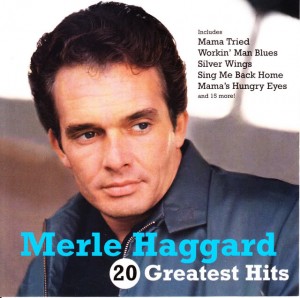 Merle Haggard 20 Greatest Hits includes songs that are pivotal to Merle’s music career. Although claiming to be the 20 Greatest Hits, the album leaves out a few big hits and includes some minor ones as well; by doing so the album gives a genuine look into the sound of Merle Haggard throughout his career.
Merle Haggard 20 Greatest Hits includes songs that are pivotal to Merle’s music career. Although claiming to be the 20 Greatest Hits, the album leaves out a few big hits and includes some minor ones as well; by doing so the album gives a genuine look into the sound of Merle Haggard throughout his career.
Bonnie Owens—
Lead Me On(1969) sang by Bonnie Owens and also Merle Haggard; Bonnie was the “closest she ever got to a hit” says 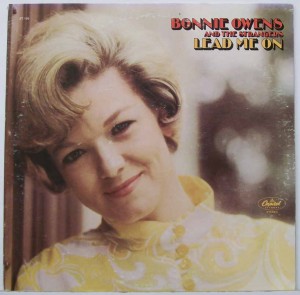 Merle. Bonnie Owens, although very talented, was overshadowed by the big names in Bakersfield Sound. She gained more recognition with Lead Me On but was never able to make it a big hit.
Merle. Bonnie Owens, although very talented, was overshadowed by the big names in Bakersfield Sound. She gained more recognition with Lead Me On but was never able to make it a big hit.
Annotated Bibliograph
1. Atkins, John. Roots of Country: Rose Maddox. Maverick124 32-35
As a child, Rose Maddox and her family struggled because of the effects of the Depression forcing her and her parents to move out west to Oakland, California looking for gold, until something changed their fate. Rose and her brothers created a band named The Maddox Brothers and Rose, eventually managed by their mother Lula. But when the United States joined WWII, their band’s career was put on hold because her brothers had to go off to war. After Rose’s brothers returned from the war, they signed with 4 star label and started a successful career as a small band. Soon after they started, they were invited to the Opry; this exposure allowed for Rose and her brothers to gain recognition from a wider range of audiences. After changes to the band, including the removal of her brother Cliff who had a distinctly different sound, Rose and her mother, her manager at the time, decided to fight to be released from their label because of the sporadic wages and increased payments for studio usage; Rose felt as though they were not getting the recognition that they wanted and deserved. After leaving, Rose was offered a gig with Columbia Records. Columbia did not like the use of her brothers as the backup band meaning that Rose broke off into the beginnings of her solo career, though her brothers still remained in music. Rose eventually received small recognition from large audiences including being televised on the Opry’s TV show; however, with further changes in her musical career, she signed with Capitol Records. During her solo career, she brought along her son, Donnie, as a guitarist; however, near the end of her career Rose was able to recognize, as are we, that she did not receive as much attention as was to be expected. Atkins asserts the influential power that Rose and the Maddox brothers had on Bakersfield sound although they did not receive the recognition many believed they deserved. Although Rose Maddox did not reach the fame of the newer artists, she and her brothers laid the foundation for performers such as Buck Owens to grow from; she wet the palate of California country listeners.
2. Cantwell, David. Merle Haggard: The Running Kind. Austin, TX: University of Texas Press, 2013. Print.
California’s conservative turn in the 1960’s coincided with the movement of “okies” and other migrant workers to California. With the migration of a diverse population, came diverse music and sounds that all contributed to the development of Bakersfield Sound. The leading men of Bakersfield, Merle Haggard and Owens, seemed to always be moving in different directions in style and location. Merle was representative of the working man that has struggled through hard times including the Depression, prison and years of heartache and yet still “doesn’t give a damn”. The juxtaposition of lifestyles with Buck Owens defined their careers and expanded the horizon for their shared genre of country music. With the growth of Bakersfield and its artists, there developed a growing canyon between Nashville country and West Coast country. David describes how each location was receptive to different sounds; it was not necessarily that Nashville rejected Rock N’ Roll just, seemingly, different types of the growing genre that included its blends with country music. Bakersfield grew immensely with the experimental sounds of the “big beats of western swing…loud guitars and even louder Rockabilly”.
3. Ching, Barbara. “Drawing Hard Lines” WRONG’S WHAT I DO BEST: HARD COUNTRY MUSIC AND CONTEMPORARY CULTURE. New York: Oxford University Press, 2001 Print.
With migrant workers moving to California during the hard times of the Dust Bowl, there was an interesting collection of styles and sounds of music that sprung up in California. Owens was especially interested in creating a home for his music in Bakersfield. After being told he was “too country” for Nashville, as they were refining the sound of country music in response to the Rock n’ Roll sound of Rockabilly, spurred by artists such as Elvis Presley, Owens took his talents to California. Buck Owens developed a unique sound as he experimented with a mixture of “faster tempo, a happier fiddle and pronounced guitar fills” to create his classic freight train sound defined by the fast-pace, upbeat drums and electric guitar. While his Bakersfield peers sang about “cheating, drinking and hell-raising”, Owens depicted the heartache of men under the strong hand of honky-tonkin’ women, men who were “vulnerable to feminine charms”. Owens’ distinct differences in song motifs were not the only thing that set Buck apart; although pledging to sing country music, Buck enjoyed pushing the “lines” and the boundaries to see where he could take country music. While Buck was singing “Johnny B. Goode” and flaunting his success in his Nudie suits, Merle Haggard continued to sing about the humiliation of being an outsider, the hardships of the Depression and drinking with a broken heart. Dwight Yoakam further shook up the sub-genre with covers of songs spanning many genres and his country star, sex symbol status. The unique sounds and styles of the artists that all lay claim to the development of Bakersfield sound have collectively pushed the boundaries of country music.
4. Dickerson, Deke. (2007). Album notes. Queen of the Coast. Bear Family, 2007. CD.
Although Merle Haggard and Buck Owens dominated the Bakersfield stage, Bonnie Owens, who happens to have been a wife to both of them at different times, was there for it all. Dickerson gives an interesting perspective on the life of Bonnie Owens, in her solo career and in the shadow of her leading men. Although the liner notes give primarily biographical information, the timeline that is Bonnie’s life allows for a deeper understanding of the talent that Bonnie had and sacrificed for the success of others, including Merle Haggard. Merle Haggard stated, “Bonnie sort of dropped the torch of her own career to stoke mine” as well as “I have no doubt that my success overshadowed Bonnie”. Bonnie did not receive as much public fame as her late husbands but had a grand effect on the development of the Bakersfield sound. From being the “singing waitress” to becoming a “local celebrity” at Cousin Herb Henson’s Trading Post, Bonnie was able to gain a small amount of exposure that allowed her to continue to record at Capitol Records. As her romantic relationship with Merle began to develop, Bonnie dropped her solo career to make “Merle Haggard the biggest star he could be” only to pick up her own torch later in life.Women’s role in country music has always been severely diminished by the overpowering role of male country artists.
5. Fenster, Mark A. Buck Owens and Country Music: The Direction of Meaning in The Figure of the Artist and the Genre. Austin, TX: University of Texas, 1988.Print.
In this thesis, Fenster discusses how the artist chooses his sound and how that doesn’t always mean that they get to choose their genre. In the past, and even today, there is the issue with defining an artist with “where” they should be placed and what sub-genre they belong in. Before Buck Owens’ career in the Bakersfield sound, he had a very difficult time with being successful in traditional and Nashville sound country; he had to battle with the music business causing an overflow into public spotlight with talk of what country music is and what it isn’t in Country Music Magazine. Fenster also talks about the limitation of flexibility in genres creating distinctive differences in the types of musical elements like the rhythm and musical arrangements. History behind Bakersfield sound and how it was created stemmed from the hardships of the Depression, Dust Bowl, and the before and after WWII effects. In this thesis, he talks about not only the history but the major influences of Bakersfield sound like, honky-tonk, rock and roll, pop, and Nashville sound. Eventually Buck Owens created a home for himself and his music in Bakersfield after experiencing difficulties with being “too country” in Nashville. Through all of the difficulties in his music career, he still became an inspiration in the world of country music and a gigantic success as he skyrocketed to the top under the sub-genre of Bakersfield Sound.
6. Kienzle, Rich. Liner notes. The Buck Owens Collection. Rhino Records, 1992. CD.
The eclectic group of voices that contributed to the liner notes allows for a meaningful understanding of Buck Owens’ musical career. In the era of Nashville Sound, smooth voices and string instruments, Buck’s “supercharged honky-tonk music” enthralled the masses. As previously mentioned, Buck’s experimental rhythm took on the sound of a “runaway locomotive” in his hits including “You’re for Me”, “Act Naturally” and “Love’s Gonna Live Here”. Owens received some heat by covering songs such as “Memphis” and “Johnny B. Goode” after pledging “I shall sing no song that is not a country song. I shall make no record that is not a country record…”. Although he pushed his boundaries with country music, he inspired many and defined the Bakersfield era. Buck a fan of the Beatles and the Beatles a fan of Buck, they had to send them a copy of each of his records. “Over the years people have asked me to define country music. I just tell them to listen to Buck Owens and the Buckaroos doing “Second Fiddle” says Emmylou Harris. His inspiration touched many and crossed genres to create a blend and appreciation for many styles and sounds from across the music world. Buck Owens’ life has made a lasting impression on the artists that carry the torch of country music today as well as country music itself. The liner notes of the Buck Owens Collection creates a beautiful connection between the man, the music and the listeners.
7. Kingsbury, Paul & Nash, Alanna.Will the Circle be Unbroken: Country Music in America. (p. 242-246).New York, NY: DK Publishing Inc., 2006. Print.
In the 1950s, the Depression era displaced a lot mid-west farmers and businessmen forcing them to relocate to California to look for jobs and to pursue different options. Although it was a tough time, most of them had their favorite music to bring along with them whether it be western swing, honky-tonk, and rockabilly. Through the joining of all these people and their music, Bakersfield Sound was born and began to thrive. Some of the unique sounds that were new to country music were the “trebly pedal steel, a driving 2/4 rhythm, and the freight train sound”, coined by Buck Owens. Most of the sounds were inspired by rock as well as the dancing beats that drive any Bob Wills sound. Soon after Buck Owens stepped on the scene, Merle Haggard followed; however, most of the credit for the development of Bakersfield Sound is attributed to the success of Buck Owens’ country music career. Eventually, after a while, people began to listen to Bakersfield sound over the “unmoving, decorous Nashville sound”. Kingsbury and Nash emphasize the unique influences of sound and style that each of the major artists of Bakersfield Sound had on country music and the diversification of artistry.
8. Silva, Robert. “Bakersfield Country.”About.com. Web. February.17 2015. from http://countrymusic.about.com/od/history/a/Bakersfield- Country.html.
In the 1950s Bakersfield sound emerged on to the scene and became very popular in the 60s. “It challenged the popularity of the Nashville Sound with its gritty mixture of Western swing, honky-tonk, rockabilly, and rock ‘n’ roll.” In the 1930s farmers and businessmen moved to California in order to find jobs and to strike it big. Through this migration, they brought their rustic music with them and history is changed forever. While Bakersfield sound was on the rise, it had some major influences in how it sounded; one of primary influences would have been Bob Wills with his up-beat tempo. The 60s is by far the most popular decade for Bakersfield sound due to people like Merle Haggard and Buck Owen. Even now Bakersfield sound is still influencing country music by what it sounds like and also the atmospheres of different genres and how people separate different types of sub-genres of country music. Silva emphasized the timeline and evolution of Bakersfield Sound: how it emerged, how it rose to its peak and now how it currently affects country music and how it is typified in today’s society.
Questions
- What is some of the major attributes that sets Bakersfield Sound apart from Nashville Sound?
- When we say ‘Freight Train sound’ what are we referring to?
- Describe the reasons why Buck Owens, Merle Haggard, and Dwight Yoakam can all be placed in the sam sub-genre.
